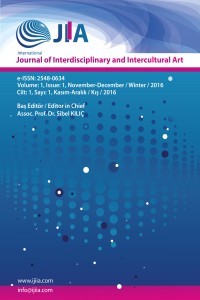ARJANTİN TANGO DANSINDAKİ DOĞAÇLAMA OLGUSUNUN DANSÇI BAKIŞ AÇISI İLE ARAŞTIRILMASI VE VİDEO ANALİZ PROGRAMI İLE GÖSTERİLMESİ
Arjantin Tango, Doğaçlama, Dansçı Formu, Dans, Tracker
INVESTIGATION OF IMPROVISATION PHENOMENON IN ARGENTINE TANGO DANCE ON THE BASIS OF DANCER AND ITS DEMONSTRATION WITH VIDEO ANALYSIS PROGRAM
Argentine Tango, Improvisation, Dancer Form, Dance, Tracker,
___
- Aricó, H. (2005). Traditional Tango - 1ra Ed. - Buenos Aires: El Autor, ISBN 987-43-9394-7. Büyüköztürk, Ş., Çakmak, E. K., Akgün, Ö. E., Karadeniz, Ş. ve Demirel, F. (2012). Bilimsel Araştırma Yöntemleri. Ankara: PegemA. ISBN 978-9944-919-28-9.
- Aydınoğlu, O. (2011). Toplumsal Cinsiyet Rolleri Açısından Tango’nun Diyalektiği. Porte Müzik ve Dans Araştırmaları Dergisi, 2(3), 1-12.
- Bender T., Boztaş M., Köseoğlu E. ve Köseoğlu K. (2016). Sanatçı Aşkının Sanatsal Yaratma Sürecine Etkileri Ve Eserlerdeki Yansımaları. İdil, 5 (23), s.879-893.
- Çevik, K. (2008). Tiyatroda yeni eğilimler: Doğaçlama tiyatro. Tiyatro Araştırmaları Dergisi. 25. 6 Aralık 2020 http://dergiler.ankara.edu.tr/dergiler/13/980/12004.pdf
- Dinçakman, B. (2015). Pina Bausch Açısından Dansta Doğaçlama. Yaratıcı Drama Dergisi, 10(1), 31-38. DOI: 10.21612/yader.2015.003
- Engin, Ö. (1997). Passionate A History of the Dance. trans: Tubitak Publications, April 18.
- Farsi, C. (2010). Mathematical Models for Argentine Tango. Bridges 2010. Mathematics, Music, Art, Architecture, Culture. Retrived 6 December 2020 from https://archive.bridgesmathart.org/2010/bridges2010-415.pdf
- Guillermoprieto, A. (2003). And They Still Tango. National Geographic, Vol. 204, No 6. ISSN 0027-9358,
- Hess, R. (2007). Tango. Ankara: Dost Yayınları. Türkçe çevirisi; Işık Ergüden. ISBN 975-298-301-4 Jaeck, L. M. (2003). The Body as Revolutionary Text: The Dance as protest literatüre in latin America. Ciencia ergo sum, vol. 10-1, marzo-junio. ISSN 1405-0269
- Karaevli, D. (2013). Arjantin Ülke Raporu, Ankara Üniversitesi Latin Amerika Çalışmaları Araştırma ve Uygulama Merkezi. 6 Aralık 2020 https://doczz.biz.tr/doc/448/arjantin-%C3%BClke-raporu-%E2%80%93-haziran-2013
- Kırkan, S. (2015). Dans Hareketi Verilerinin Sayısal Ortamda Forma Dönüştürülmesi. Yayımlanmamış Yüksek Lisans Tezi. İTÜ, Fen Bilimleri Enstitüsü. 6 Aralık 2020 http://hdl.handle.net/11527/13120
- Link, K. Q. (2009). A Thesis, Culturally Identifying the Performance Practices of Astor Piazzolla’s Second Quınteto. Unpublished Master Thesis. University of Miami Musman, M. (2010). World of Dance: Latin and Caribbean Dance. Chelsea: House Publishing. ISBN 978-1-4381-3372-0 (e-book).
- Nakano, Y., & Okada, T. (2012). Process of Improvisational Contemporary Dance. Proceedings of the Annual Meeting of the Cognitive Science Society, 34. Retrieved 6 December 2020 from https://escholarship.org/uc/item/40739507
- Nielsen, C. S., & Mariotto, J. G. (2005). The Tango Metaphor the Essence of Argentina’s National Identity. Int. Studies of Mgt. & Org., vol. 35, no. 4, Winter, pp. 8–36. ISSN 0020–8825 / 2006
- Olszewski, B. (2008). El Cuerpo del Baile: The Kinetic and Social Fundaments of Tango. Body & Society. Vol. 14 No. 2. Protopapadakis E., Grammatikopoulou A., Doulamis A., Grammalidis N. (2017). Folk Dance Pattern Recognıtıon Over Depth Images Acquıred Vıa Kınect Sensor. The International Archives of the Photogrammetry, Remote Sensing and Spatial Information Sciences, Volume XLII-2/W3. Retrieved 6 December 2020 from https://core.ac.uk/reader/193486100
- Savigliano, M. E. (2010). Critical Essays: Notes on Tango (as) Queer (Commodity). Anthropological Notebooks. 16 (3): 135–143. ISSN 1408-032X. Tracker. (2019). Video analiz ve modelleme aracı. 6 December 2020 https://physlets.org/tracker
- UNESCO (Culture Sector). (2009). Tango: Decision of the Intergovernmental Committee: 4.COM 13.01. Retrieved 6 December 2020 from https://ich.unesco.org/en/RL/tango-00258
- Yiğit, G. (2017). Çatışma Kavramın Carlos Saura’nın Tango Belgeseli Bağlamında İncelenmesi. Yayımlanmış Yüksek Lisans Tezi. Haliç Üniversitesi Sosyal Bilimler Enstitüsü, Tiyatro Yüksek Lisans Programı.
- Wee, L. K., Tan K.K., Leong T. K. and Tan, C. (2015). Using Tracker to understand ‘toss up’ and free fall motion: a case stud. Phys. Educ. 50-43.
- Başlangıç: 2016
- Yayıncı: Sibel KILIÇ
BİR ÇAĞDAŞ SANAT GÖSTERGESİ OLARAK TOPLUMUN GÖLGESİNDEKİ ÇÖPLE YÜZLEŞME
PIETER BRUEGEL’İN JANR (GÜNLÜK YAŞAM) RESİMLERİNDE KIRSAL BELLEK
Mehmet NORASLI, Ali AKÇAOVA, Fatih MAZLUM
ÇAĞDAŞ TÜRK RESİM SANATINDA SANAT EĞİTİMCİSİ VE SANATÇI KİMLİĞİYLE BİR DEĞER VEYSEL ERÜSTÜN
ERKEN CUMHURİYET DÖNEMİ TÜRK RESMİNDE OKUMA YAZMA SEFERBERLİĞİNE DAİR YANSIMALAR
DİJİTAL GİYSİ TASARIM YAZILIMLARI VE KADIN GİYİMİNDE KULLANIM OLANAKLARI
Kemal YILDIRIM, Kübra MÜEZZİNOĞLU, Cem ÖZTÜRK
OSMAN HAMDİ BEY’İN RESİMLERİNDE TİNSELLİK
MARX’IN EKONOMİ-POLİTİK KAVRAMLARI BAĞLAMINDA HAUPTMANN’IN DOKUMACILAR ADLI OYUNUNUN ANALİZİ
